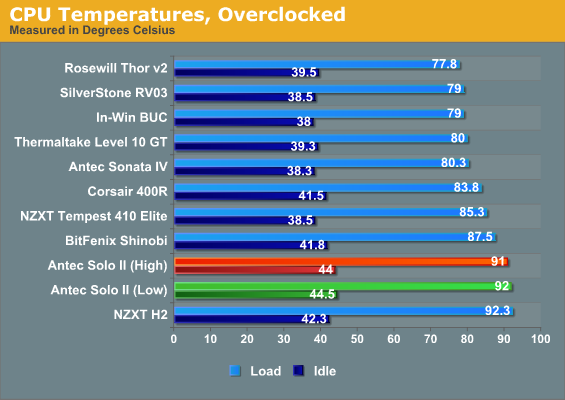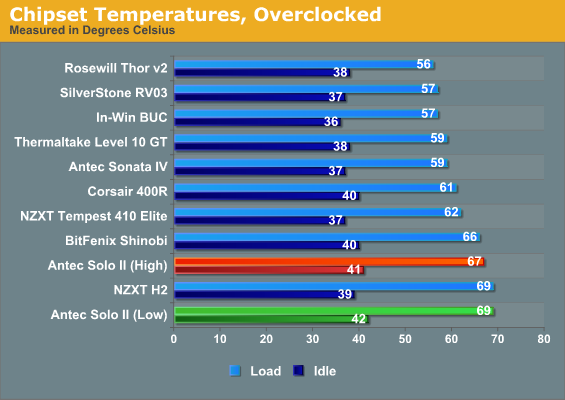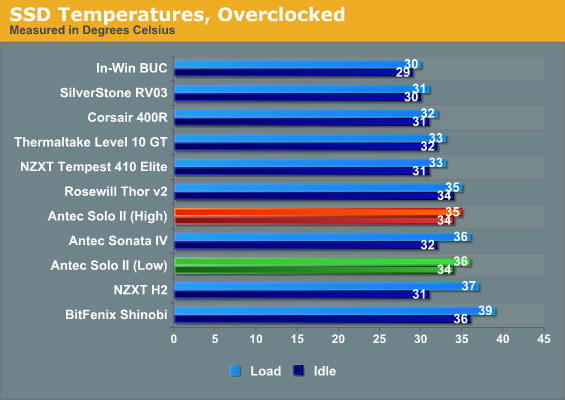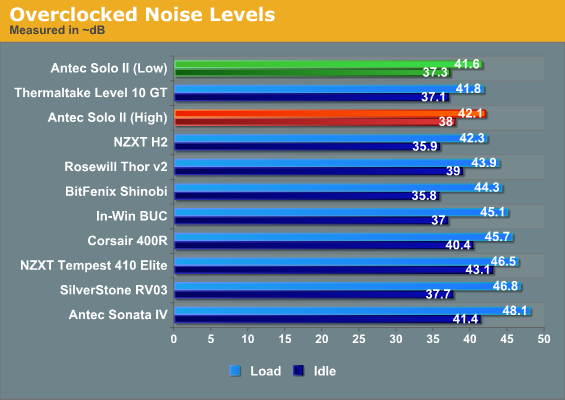Antec Solo II Review: Sonata Evolved
by Dustin Sklavos on September 6, 2011 12:00 AM EST- Posted in
- Cases/Cooling/PSUs
- Antec
- mid-tower
- Sonata
Noise and Thermal Testing, Overclocked
Given the high temperatures of the Antec Solo II in just our stock testing, it's with some trepidation that I even began testing it overclocked. For what it's worth, the Solo II stayed quiet through testing (although the character of the noise was a bit higher pitched than I'd prefer). Unfortunately you could also touch the side panels of the case and really feel the heat radiating off of it.





Once we get into overclocked testing, the Solo II's design actually starts to feel a little more balanced and it begins to separate itself from the NZXT H2. Unfortunately, the BitFenix Shinobi continues to be a thorn in its side as a reasonable alternative in terms of both aesthetics and the mixture of thermal and acoustic performance.

It may be cooking the testbed, but the Solo II does continue to do so with a minimal amount of noise. The acoustic insulation in the enclosure pays off in spades; only the giant (and twice as expensive) Thermaltake Level 10 GT can really compete.










59 Comments
View All Comments
gevorg - Tuesday, September 6, 2011 - link
"I also think Antec is having the same problem with the Solo II they had with the Sonata IV: it's priced right out of competition. At $129 it just doesn't make sense."It makes sense to people who value silent computing. With the right part selection you can have a powerful computer that is also very quiet and that what makes Solo superb even at $200 price point. Comparing Solo to Sonata is like comparing apple to an orange. Key word: part selection. A proper review with anechoic chamber measurements would show a clearer picture.
zero2dash - Tuesday, September 6, 2011 - link
@ $120 the Solo II is (IMHO) grossly overpriced.@ $200 it's highway robbery and anyone who would buy a Solo at that price point deserves to get ripped off.
If I have $200 and it HAS to be spent on an Antec case, I'd get one of the 18x variants. Otherwise, I'd go with another brand name.
knedle - Tuesday, September 6, 2011 - link
I agree, I have Antec NSK2480 for years and I didn't buy it because it was fancy, featured some neat mounting system or whatever else.I bought it because it looked simple, and was made of thick steel, that helps to make my computer quiet.
Nothing else counts for me, and that enclosure is doing great job for me... Oh wait, I had to turn off all the blue LEDs on it, because I hate them. ;)
pvdw - Tuesday, September 6, 2011 - link
Anandtech just doesn't have the facilities for a proper sound related review of hardware. For that SPCR is a better place to go. If quietness is a priority then that's the place to go for reviews. I've found that their case reviews are better than those here. I'm sure they'll review this case and I look forward to hearing their input.BTW, I have the Solo, and it's a great case! It has it's little foibles, but it's significantly cut down on noise in my office.
As far as tool-less design is concerned, remember that a case like the Solo is geared towards noise reduction. It's possible that some of the tool-less designs lead to extra vibration. Or maybe Antec were just cutting corners.The suspension straps are just the best at reducing HDD vibration transfer.
gevorg - Tuesday, September 6, 2011 - link
"Anandtech just doesn't have the facilities for a proper sound related review of hardware. For that SPCR is a better place to go."If Anandtech can't do a proper review, they shouldn't jump to silly conclusions that Solo "at $129 it just doesn't make sense". Not everything is made for overclockers, storage servers and HTPC.
Dustin Sklavos - Tuesday, September 6, 2011 - link
I stand by my conclusions.Just because we can't invest in a custom built anechoic chamber that produces noise level results which border on academic for 90% of end users, I'm somehow not qualified to be doing these?
davegravy - Tuesday, September 6, 2011 - link
Acoustic Engineer here.Results can be significantly skewed by not measuring in an anechoic environment due to room modes. We're talking on the order of several dB.
Your measurements may still be useful for comparison purposes, provided your transducer location and the location of equipment under test is EXACTLY the same for each measurement. In this case, one should not compare Anantech's results with other published results.
Dustin Sklavos - Tuesday, September 6, 2011 - link
That's basically it. I'm confident that my results are comparable within their own ranks.dhanson8652 - Tuesday, September 6, 2011 - link
I think this is a fair review. I have no major problem with this review and I've been a SPCR regular for almost a decade.Suspension was a big deal with traditional 7200 RPM drives back in the day. With SSDs taking over it becomes less and less of an issue. I'd be fine with suspension taken out of the Solo if it dropped the cost and that was reflected in a lower price for the consumer.
The biggest negative you didn't mention is the power button / reset switch is pretty cheaply made. See the picture in page two of this thread http://www.silentpcreview.com/forums/viewtopic.php... I've seen ham-fisted users bust the power button on a Solo and I've had to fix them so it's not an issue I'll quickly forget.
The one thing that I didn't know before reading this review is that the support bar is removable. There have been some on SPCR that have cut the bar away in the original Solo so having it easily removed/replaced without damaging the cases resale value is a plus.
On the topic of intake the lack of intake fan, considering Yate Loon 120mm fans are only $3 retail (less for someone like Antec to buy in bulk) It'd be very easy to up the included fan count by one if they are going to keep the price that high. As is die hard SPCR types don't use front fans.
leoc - Saturday, December 28, 2013 - link
The really important difference between this review and the SPCR one isn't the precision of the noise recordings. It's that when SPCR found the stock Solo II struggling under load with a mid-range GPU they went ahead, put in a 120mm intake fan and retested. Apparently the Solo II was not only much cooler but quieter with the second fan while under load. Now it would be very fair to slate the expense of what's arguably a $15 hidden extra on the price of a $130 case, but it's faintly absurd not to confirm that the case works well in a two-fan configuration. I understand the desire to review the item as delivered and not to consider esoteric modifications, but throwing in a 120mm Nexus is not exactly drilling holes: it's a ridiculously straightforward and obvious option when self-building a desktop PC for superior noise *or* cooling performance.